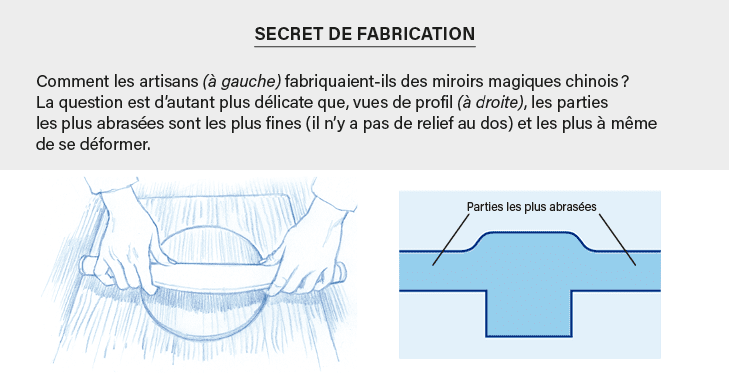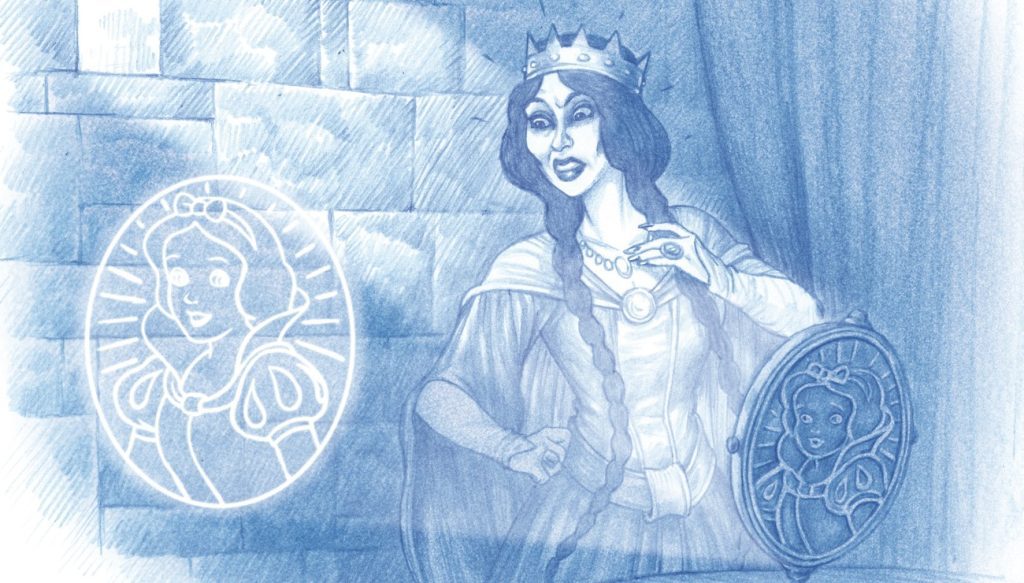Snow White, Harry Potter, Donkey Skin, Beauty and the Beast… all these tales share a mirror display with amazing characteristics: to tell the truth, to manifest the deepest desires, to reveal distant scenes … These things are of course imaginary, but there are magical mirrors that do exist. Well, they are Chinese.
These devices are stunning double-sided bronze artifacts. On the reverse side is a relief engraving for decorative purposes. The place is polished to a mirror. If a close examination of the reflective surface reveals nothing special, the latter, illuminated by a point source, projects an image on a distant screen, often, but not always: thus the magic mirror recently found in the reserves of the Cincinnati Museum of Art, in the states United, the Buddha appears surrounded by a luminous halo without appearing on the back of the piece. In any case, the image has the peculiarity of remaining sharp, whatever the distance between the mirror and the screen. What is the secret of these mirrors? The laws of optics help us see (a little bit) more clearly.
han knife
These mirrors, which are a few centimeters or tens of centimeters in diameter, were made in China and Japan for thousands of years, the oldest dating back to the Han Dynasty, during the past two centuries BC. It is obtained by casting bronze into a mould, and then by polishing the flat face to obtain a slightly convex mirror, that is, domed. They are known in Chinese as Tu Kuang Ching Which means “light transmitting mirror”. However, this idea of transparency does not hold up to it. Even if its surface during its manufacture was subjected to abrasion for a long time to reduce its thickness as much as possible, no light will pass through it.
Before giving a plausible explanation for the phenomenon, according to the tradition of the British physicist and crystallographer Sir William Henry Bragg, who studied these mirrors in 1933, let us first survey some of the explanations that still circulate. The first is that a colored or black pattern is deposited on the surface of the mirror and then covered with a very thin layer of bronze. It’s actually effective at projecting images from an entirely mirror-like surface into direct observation, and this process is also used to easily make bad copies of these “magic mirrors.” However, an examination of the image produced by these copies shows significant differences from the original. With copying, the edges are clean with a clear transition between a dark area and another light, as in shadow puppets. With a real magic mirror, the image consists mostly of strokes, each consisting of a dark line next to a light line.

According to another interpretation, during polishing, small concavities, hollows, form in the areas separating the thick and thin parts of the mirror. Unfortunately, this type of defect does not produce the expected effect: the reflected light is focused a short distance from the surface; Thus the image quickly becomes blurry when you move the mirror away from the screen.
A third explanation, which is based on experiments, involves volume changes associated with solidification and then cooling of the bronze. The mirrors were machined, then polished, and finally heated. During this heating, the fine areas, which heat up more quickly than the thicker areas, expand more quickly and create bumps on the surface. These lead to the formation of images, but they gradually disappear as the mirror cools. A quick tempering process will certainly help to freeze the deformations, except that this interpretation has two drawbacks: on the one hand, surface deformations, warped, are visible to the naked eye, and on the other hand, there is no historical source describing such deformations. Methods.
A recipe for a clean mirror
The solution is simpler for the craftsman and more accurate for the physicist. In the 1980s, a Chinese team decided to manufacture their own mirrors to understand this phenomenon. The first stages of the process are “standard”: pouring molten bronze into a mould, cooling, scraping the top face to make it slightly convex, and then polishing. After these steps, the obtained mirror could not be more classic and no image was reflected on its surface.
Then the researchers resumed the scraping process to reduce the thickness of the mirror in stages. After surgery, the mirror was polished and then visually tested. Then a distinct image gradually appeared as light was reflected from a point source until the image quality of a magic mirror was obtained when the thinnest parts were only on the order of a few millimeters thick. This is on top of how Yamamoto Akihisa progresses today, one of the rare magic mirror manufacturers operating in Kyoto (Chinese magic mirrors were exported to Japan from the thirde Century): In the 1970s, he rediscovered the manufacturing method of his predecessors.
Erosion alone can have a mechanical effect, with different surface erosion to distinguish thick and thin areas. Then a kind of smooth step, a difference in plane, appears between these areas: part of this step is concave and focuses the light beam, while the other is convex and scattered it. The result is that we get in the projection a line consisting of a light part, on the side of which the step is concave, and a dark part, where the step is convex.

Think carefully before planning
This is not all. If you move on a flat surface, the light will focus a short distance from the mirror, and as mentioned above, the image will become blurred once you move the screen away. For this reason, the mirrors are slightly convex, which causes parallel rays that reach the surface to diverge. Finally, the image enlarges with distance (this is the principle of magnification of bathroom mirrors), but it also remains sharp, because the convexity pushes the focal distance of the hollows back. Thus the image retains the same appearance when the display screen moves away from the mirror, with the thickening of the image line, which accompanies the enlargement of the image itself. Des mesures par interférométrie laser confirment l’existence de ces marches et expliquent pourquoi on ne voit rien à l’œil nu : c’est parce que les différences d’épaisseurs sont de l’ordre du micromètre, soit du’ centiètre hair! The fact remains that its effect is clearly visible. Enough to give ideas for surface flatness testing, like a silicon wafer for example!
However, some questions remain unanswered. Thus, in the most common mirrors, where the back and the image coincide, we perceive that these raised areas of the surface correspond to the thicker areas of the back. In other words, the wear on the thinner parts of the mirror is greater than on the thicker parts. This is surprising, as one would expect that under the pressure of the scraping tool, the thinner areas flex and are less offensive than the thicker ones. And in the rare few mirrors that the projected image has nothing to do with the inscription on its back, when there is one, was the latter fused to a first inscription on the reverse of the image? The origin of the image seen? We ignore it. If the optical mystery of Chinese mirrors is well explained, we still have to understand the secrets of their manufacture. Maybe ask the magic mirror in the movie partner ?

“Music guru. Incurable web practitioner. Thinker. Lifelong zombie junkie. Tv buff. Typical organizer. Evil beer scholar.”






More Stories
A large manufacturing project awaits space in the industrial zone
According to science, here are officially the two most beautiful first names in the world
Green space, 100% pedestrianized: DIX30 reinvents itself